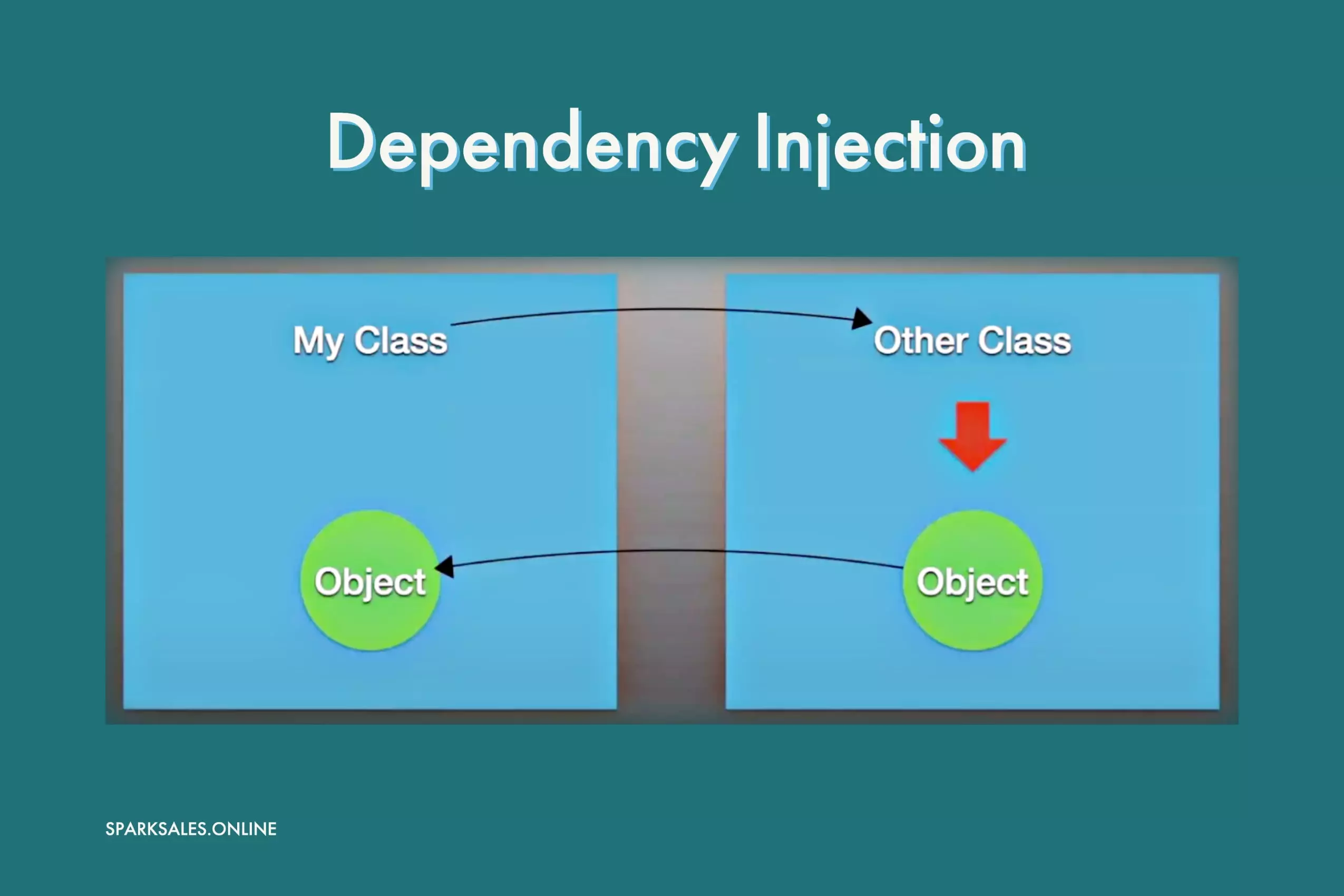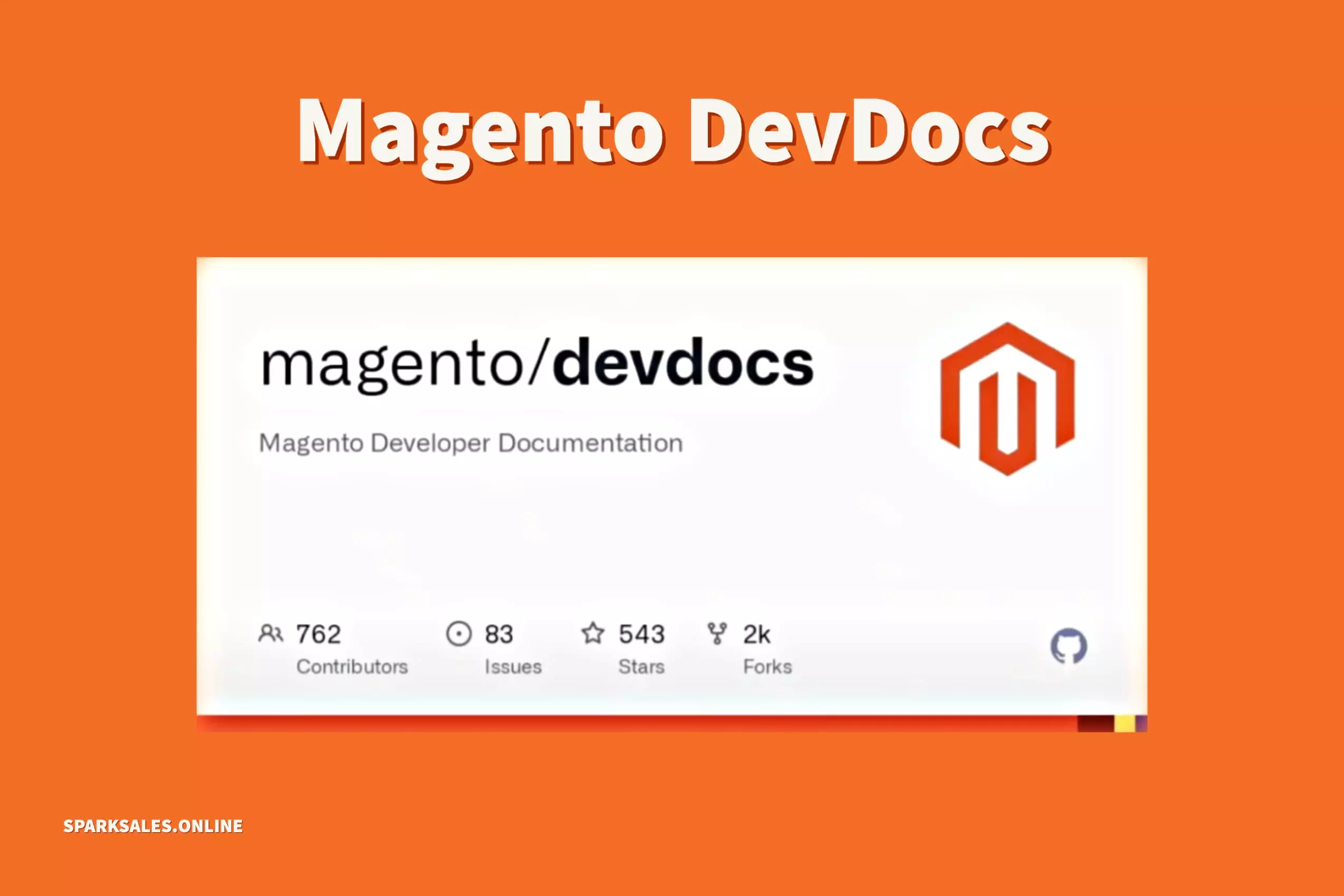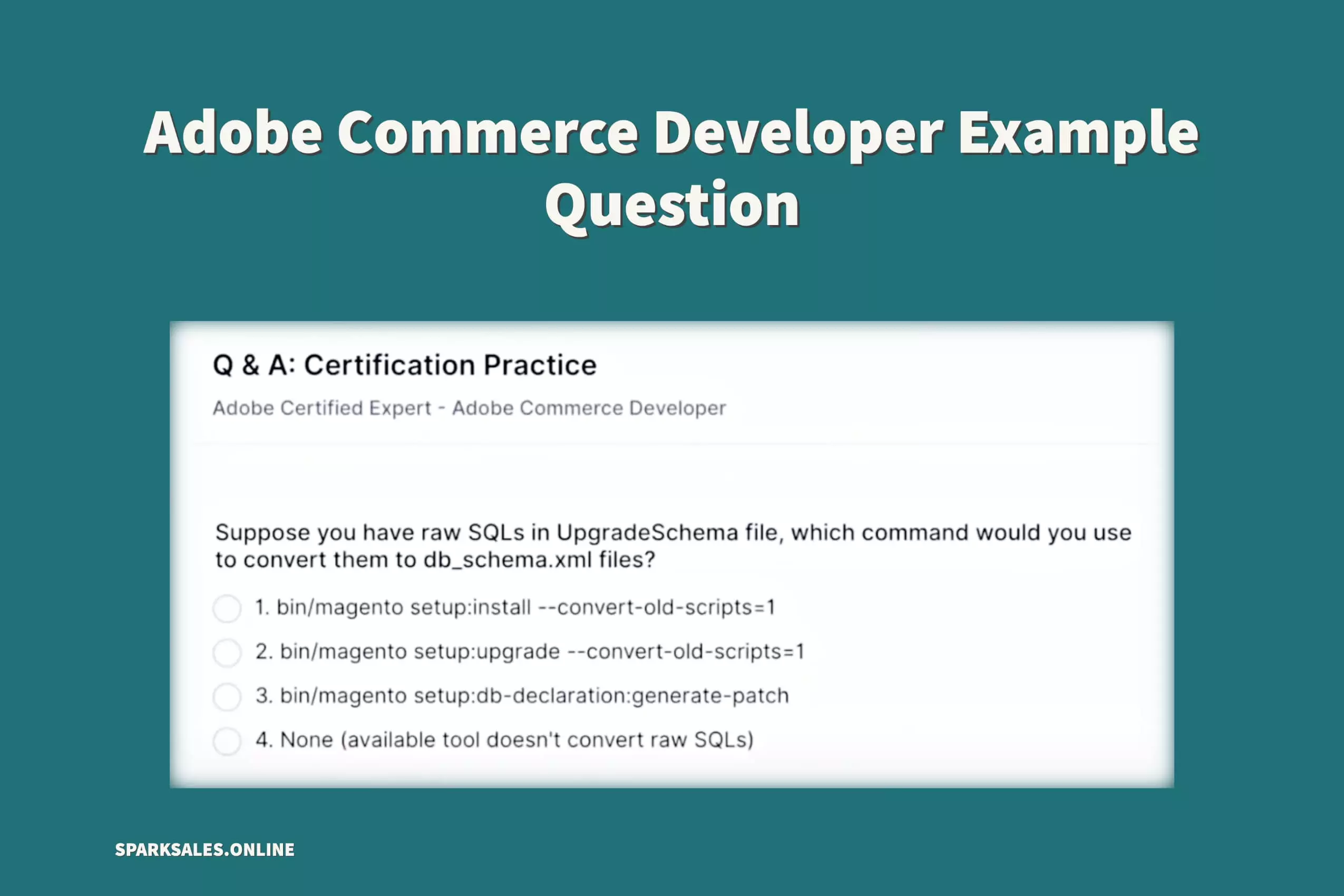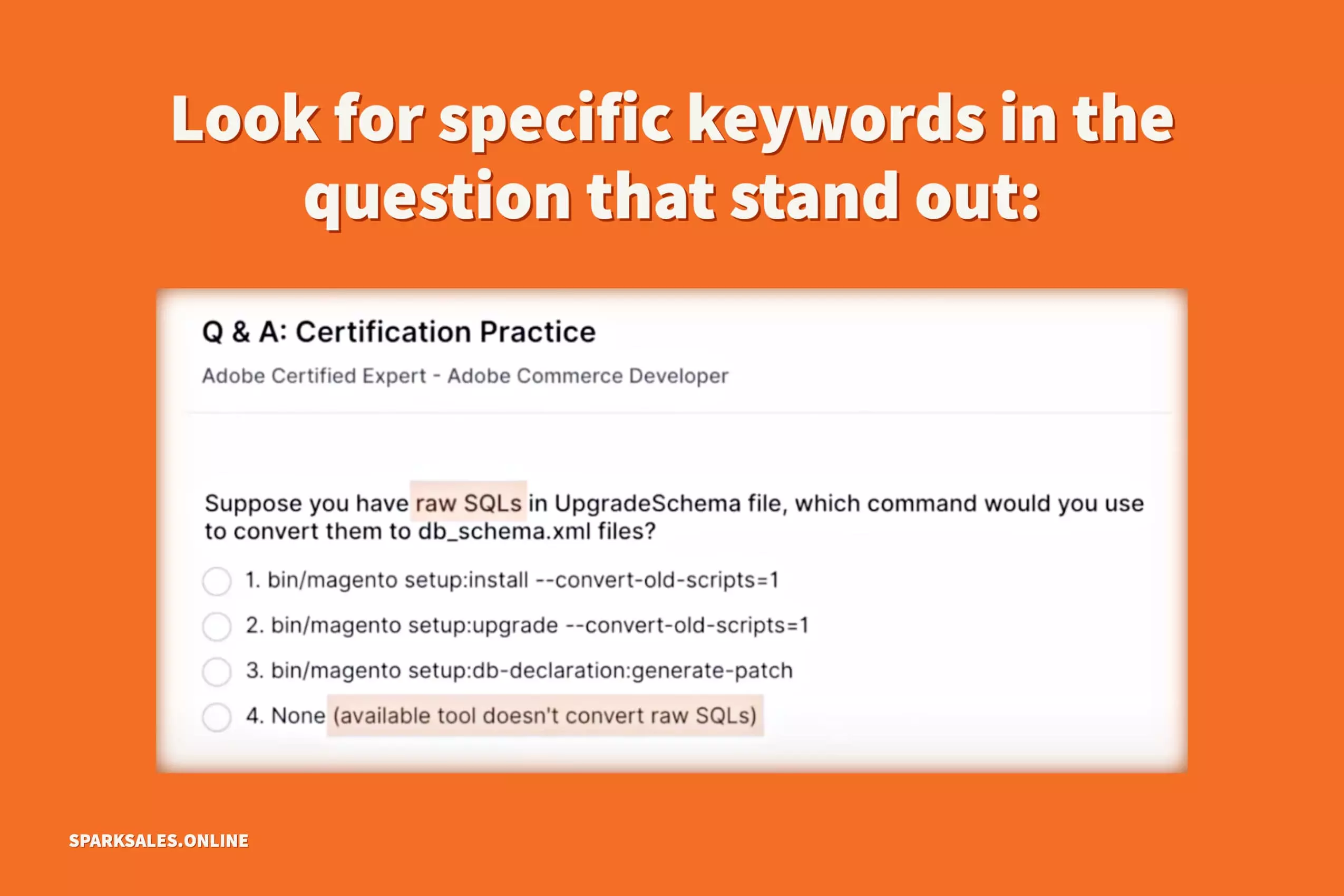Notice: Undefined variable: echo in /var/www/kabazoo/data/www/spark.crisp-studio.com/wp-content/themes/SparkSales_Final/header.php on line 140

Today we are looking into the journey towards becoming a certified Magento developer. First, we’ll cover the “How do I get certified?” question and then look into the most common struggles with Magento. I’ll also go into steps you can use to pass the notoriously difficult exam and what you can do after you pass or fail.
I would recommend the Adobe Commerce Developer cert, which used to be called the Associate Developer Certification. You pretty much have three steps to be able to pass this cert successfully:
Most people just focus on the second step: prepping for the test, and if you do that, you’re going to wind up being confused, lost or not knowing the material. Also, it’s true that if you don’t have some test-taking strategies up your sleeve, you can know the material and still not do well on the test.
Step one is understanding the architecture and focusing on the fundamentals. Speaking of fundamentals, this is my favourite question for developers: “What is dependency injection?” You’d be surprised; about 90% of devs just can’t answer this. So many want to get certified, and they still can’t answer this question.

Let’s quickly cover what dependency injection is. Typically when you create a class or object in Magento, you use the new keyword right where you want to, within your own class. All dependency injection is, is another class instantiating your dependencies and your objects for you. It then returns that object to your original class. Object manager is the name of this class that creates these objects for you, also called the dependency injection container.
That’s pretty much all dependency injection is. It’s pretty simple, but why would you use dependency injection? You’d mostly use dependency injection because it decouples dependencies directly from your code, making things easier to test. Also, since one class can now control how objects are created, you can add some magic to those objects, which is actually what Magento does with helper methods and so on.
You need to understand what’s going on behind the scenes with these terminologies and aspects, and that’s not just dependency injection but everything else in Magento. So you really have to focus and understand how it works, and it’s like this for many people with a lot of things. Most people just don’t get something unless they truly understand it, inside out. This is where Magento gets complicated because there’s so much to take in, everything from extension attributes to all these interfaces, interceptors and a tonne of other weird names.
You just have to focus on one thing at a time and slow down. It all can be overwhelming, but if you just focus on one thing, it’ll make things drastically easier. Also, make a conscious effort to avoid getting overwhelmed with the terminology. They’re just names for specific patterns or things to do, just like the dependency injection example.

Well, there are a few ways. The first resource I recommend when it comes to any framework is the dev docs. It’s a fantastic resource, and sure there are some spelling mistakes here and there. But, still, overall, it’s a tremendous resource, and it’s great that you have this to refer to because it’s tonnes of documentation, and it’s added to and updated every day.
Start with the dev docs and then the core code. Crack open your IDE and look through the core code. If you dive deep enough, you’ll begin to see specific patterns emerge, and you’ll truly understand how things work the way they do. Well, at least 80% of it, right? Of course, there’s always certain aspects of the framework that you just won’t understand, and that’s okay too.
You also need some real-world experience. If you know it, you should be able to prove it, and that’s pretty much the gist of the certification. Go ahead and build a real module, find something open source or an idea in the marketplace and try to rebuild it. That’s how you will gain authentic, real-world experience, and it’ll help refine all of your knowledge about Magento. Many try to bypass this step, but it’s best not to if you want to pass your cert test.
Once you have a solid understanding of the fundamentals and foundation of Magento 2, you need a process to pass these exams. The skill level on these certs I’d say, is highly challenging, so please do not go into this thinking it’s easy. Remember, you can’t get certified if you don’t understand the core fundamentals, so that’s the entire reason for taking the test. You also need working experience with M2, and you need to learn some strategies for passing this test because even experienced devs can come across a question that’s asked a certain way, and they won’t be able to answer it.
You need to set some conditions and go all in once you decide to get certified. Don’t change your mind; set some constraints, set a date and work towards it. Pick a date maybe a month away; that would be a reasonable time frame, and then commit to the test. Then, once you decide to do it, just do it and follow through.
The first step in cert prep is to take SwiftOtter’s practice tests. They’re fantastic. You can take four tests for around £15, so it’s really cheap. However, you need to be honest with yourself the first time you take it. Don’t cheat or take it more than once right away because that way, you’re just kind of cheating yourself, and that initial cert test helps set a baseline of your knowledge about Magento for the main test.
Just don’t be too disappointed if you receive a low score your first time around on the practice tests. Remember that this tells you what you don’t know, which is a good thing, and it shows you what you should focus on. You can ignore the different objectives at the bottom of the result card that you know you’re already good at. Instead, you want to ensure that you’re using your time efficiently and focussing on the items you don’t know.

This is a test question that was doing the rounds recently, and it’s an excellent practice example for the exam. Let’s look at it and see if you can work out the answer:
“Suppose you have raw SQLs in UpgradeSchema file; which command would you use to convert them to db_schema.xml files?”
This is actually a straightforward question to answer if you have Magento experience and test-taking experience but let’s break it down. First, you want to deduce and eliminate answers.
The first option, setup:install; if you’re familiar with Magento at all, you know that this is used when setting up a new Magento instance, so it can’t be that one.
The third, the setup:DB-declaration:generate-patch, that’s used to generate data patch scripts which is not what the question is asking for, so that one also can’t be the answer either.

This leaves us with answers two or four, so most people who get this answer wrong will choose one of these options. Let’s reread the question and look at how it’s phrased. First, you want to look for a phrase in the question that stands out to you.
When I do this, I immediately see ‘raw SQLs’ that definitely stands out to me and tells me the question’s direction and focus. Then you also want to check the phrasing in the answers. Just because the fourth answer also contains ‘raw SQLs’ doesn’t necessarily mean it’s the correct answer, but it gives you a hint of what they’re looking for you to prove with this question. It doesn’t mean it’s the correct answer, but it very well could be.
Once you deduce and eliminate that setup:upgrade cannot convert raw SQLs, you know it’s most likely that ‘available tool doesn’t convert raw SQLs’ is your answer. You can look for an answer to also be proved wrong, which will help you get to the correct answer. Some questions will be similar but not exactly like this on the practice tests.
Richard Feynman has a great quote that’s pretty apt for understanding framework fundamentals. He was an astrophysicist that was around a long time ago. “Understand. Don’t memorise. Learn principles, not formulas.” It’s essential to understand the underlying concept rather than focusing on predefined answers.
I’ve heard of people who actually even purchase brain dumps for certs, and they’ve failed miserably. It’s designed to be extremely difficult, which makes earning the cert so much more respected. So remember that you want to focus on the core concept of what’s being asked, not the direct answers.

I’m actually not a big fan of study guides because they’re usually bloated; they’re huge and stuffed with lots of information that may or may not even be on the test. However, it can be good to glance over the main topics and the more significant ones. Otherwise, I don’t think they’ll help you too much, so focus on the process and reasoning rather than the brute strength of trying to remember specific questions and answers.
Now repeat the process; after you’ve done some studying and cert prep, retake the practice test and see how you do. You may get questions that are also not in the first pool of questions which is good because if you do poorly on any of these, don’t worry. Just take a step back, repeat the process and stay committed to your end goal.
When you’re finally ready, let’s say you have a high percentage passing score in the practice test or you’re very confident; just schedule it already! Of course, it’s easy to put it off once you already know all of this stuff because of fear of the unknown or fear of failure, but don’t let that hold you back. On the other hand, unless you’re pretty sure you’re going to pass, you don’t want to repeat this entire process because it takes a lot of time, make sure that you’re being honest with yourself.
If you know your fundamentals and have studied for the test, the last step is prep. You shouldn’t get overwhelmed at this point. You already know this stuff, and you’ve proved it in the practice tests, so when you’re finally in the test centre, just try to calm down and focus on the test.
If you’re stuck or don’t know something, don’t answer it. At the end of the test, you can review questions that you haven’t answered, and most of the time, when you see a question the second time around, it’ll make a lot more sense after a mental break. If you kind of know something, there’s a star flag in the actual exam when you take it, so again if you’re not sure of the answer, star it and revisit it later and then try to find a specific situation that they’re asking you to prove.
The test is all situation based. If you’re really confused, focus on the keywords they’re asking for and the point they’re trying to get across. But, again, they’re looking for you to know a specific piece of knowledge, so keep that in mind.
You get two hours for all of the tests, two hours is a lot of time. They give you a lot but make sure you use all of it. You don’t get any extra points for finishing early. No one knows how long you took to take this exam. I routinely use almost the entire time allotment when I take a test because I want to do my best to make sure I pass the first time around. I’ll go through the entire test and all the questions and answers about three times. Seriously, check over everything until you’re super confident to submit it.
If you really don’t know the answer, pick a number or letter before starting the test, either A, B, C, D or 1, 2, 3, 4. For example, let’s say you pick ‘C’ or 3. So then, every question you don’t know gets this answer; if you can’t make an educated guess or you think they’re tricking you, just put down ‘C’.
I remember not doing as well as expected in a French test in high school, and I actually still passed because all of my guesses had the answer ‘C’, and apparently, the maths worked out! It’s a tip that my maths teacher taught me in high school, and it works. Also, remember that you can miss a lot of the questions on the test and still pass.
When you visit that desk after you submit your test, it’s always stressful waiting for the results and if you fail, use it as a learning experience. You just went through a significant learning process, and you’ve now done this before. So you’ll be prepared for when you do this again.
Granted, you won’t know the specific questions you got wrong, but you’ll have an idea and a general reasoning of the ones you’ve missed because they would have felt awkward or weird to you, or you wouldn’t have known the answer directly.
Try to memorise those questions as best as you can and focus on the answers when you leave the testing facility. You can also retake the exam five times, and you get a 20% discount on retakes, so there are some silver linings to failing, but there’s also only one thing that matters, that you pass the exam. The score doesn’t matter at all, this is a pass-fail exam, it’s not a percentage, and no one knows those results unless you tell them, so if you get 68%, great, you passed!
After you pass, congratulations! You did it! Share your badge every place you can online, and in a few days, you’ll have your cert badge emailed to you so you can share it everywhere. It’s a fantastic achievement and something you should be very proud of.
Now you also have a duty to help out your co-workers and friends of others to pass this test. You want to share the strategies that you devised along the way. Maybe you learned something specific or came across something that you stumbled upon, and it might help others on the test as well.
I hope this article was beneficial, brought you value and gave you some ideas on how you can become a Magento Certified Developer. If you want to know more about ecommerce in general, I highly recommend checking out our other articles. Make sure you share this article with a friend, and if you have any additional questions or comments, please leave them in the comment section below.
Subscribe to our posts
This page requires cookies to give you the best possible experience. Read our Cookies Policy to learn more.
This page requires cookies to give you the best possible experience. Read our Cookies Policy to learn more.
Comments